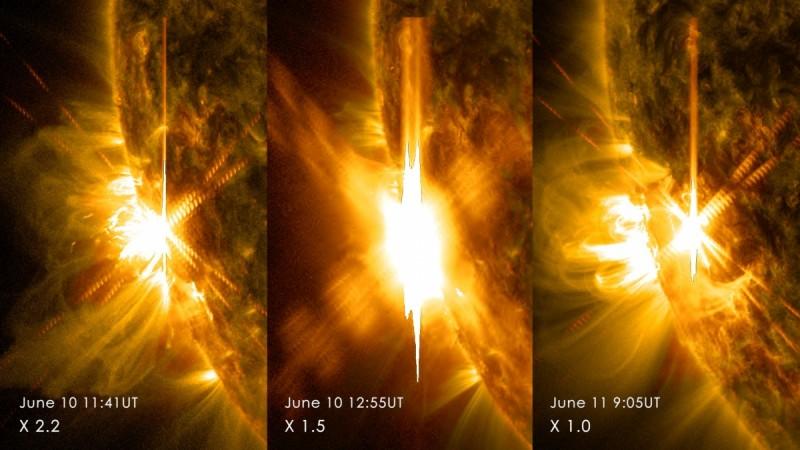
The sun has released three powerful solar flares in the past two days, the effects of which could hit Earth on Friday 13 June, according to a report by National Oceanic and Atmospheric Administration (NOAA).
But, there is no cause of fear for people on Earth as the flare will have small or no effect on the planet, reports Space Weather.
The solar flares disrupted high frequency communications on the Earth, when it hit twice in the morning hours of Tuesday 10 June and once on Wednesday 11 June between 7 a.m. and 9 a.m. EDT or 4:30 p.m. and 6:30 p.m. IST.
NASA's Solar Dynamics Observatory (SDO) captured the images of the flare. The flares were 10,000 times as intense as normal flares from the sun and erupted from an active region on the left side of the sun.
All of the three activities were X-Class solar flares, which is the most powerful type of solar flare. On Wednesday, X1.0 flamed following two X-flares (X2.1 and X1.5) on Tuesday 10 June. The most recent blast was short-lived but intense and is not expected to have significant effects on Earth, said NASA officials in a statement.
Solar flares are huge bursts of radiation from the sun that explode into the space. They can produce coronal mass ejections (CMEs) - shockwaves of plasma and charged particles. When these waves direct towards Earth, CMEs can activate geomagnetic storms and blackout power grids and communication on Earth. So far, scientists have not observed morning flares association with CME. But the flare that blasted on Tuesday produced a CME, which the scientists forecast to hit the Earth on Friday 13 June.
It is expected that the CME could create polar geomagnetic storms – occurs when solar particles connects with Earth's magnetic field.
The solar flares produced on Tuesday and Wednesday caused radio knock out that interrupted high-frequency communication for about an hour on the regions of the Earth facing sun, according to the U.S. Space Weather Prediction Center (SWPC), which is based in Boulder, Colorado, as reported by Live Science.
Though harmful radiation from a solar flare cannot pass through Earth's atmosphere to affect humans on the ground, intense flares are capable enough to disturb the atmosphere where GPS and other communications signals travel.
It is predicted that the geomagnetic storm that will hit on Friday will produce a G1 storm, which is the least intense type of storm. In such a case, communication instruments are unlikely to get disrupted. Also, there is no strange aurora display forecasted by space weather experts.
Moreover, as and when the sun rotates, it could burst out additional flares directly at Earth, according to Spaceweather.com.
Powerful flares associated with CMEs can also be dangerous to astronauts on board the International Space Station (ISS) and could interrupt with satellites around the planet.
Check out for the video of the two flares recorded by NASA's SDO
















